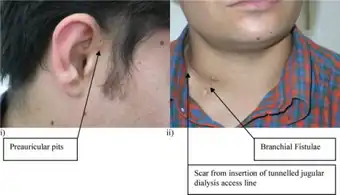Branchio-oto-renal syndrome
| Branchio-oto-renal syndrome | |
|---|---|
| Other names: BOR syndrome, Branchiootorenal syndrome | |
 | |
| Branchio-oto-renal syndrome has an autosomal dominant pattern of inheritance | |
| Symptoms | Ear abnormalities[1] |
| Causes | Mutations in genes, EYA1, SIX1, and SIX5[2] |
| Diagnostic method | Laboratory test results, Physical exam[3] |
| Treatment | Branchial fistula may need surgery[3] |
Branchio-oto-renal syndrome (BOR) , is an autosomal dominant genetic disorder involving the kidneys, ears, and neck. It often has also been described as Melnick-Fraser syndrome.[2][3]
Signs and symptoms

The symptoms and/or signs of branchio-oto-renal syndrome are consistent with underdeveloped (hypoplastic) or absent kidneys with resultant chronic kidney disease or kidney failure. Ear anomalies include extra openings in front of the ears, extra pieces of skin in front of the ears (preauricular tags), or further malformation or absence of the outer ear (pinna). Malformation or absence of the middle ear is also possible, individuals can have mild to profound hearing loss. People with BOR may also have cysts or fistulae along the sides of their neck.[1] In some individuals and families, renal features are completely absent. The disease may then be termed Branchio-oto Syndrome (BO syndrome).[4]
Cause
The cause of branchio-oto-renal syndrome are mutations in genes, EYA1, SIX1, and SIX5 (approximately 40 percent of those born with this condition have a mutation in the EYA1 gene).[1][5] Many different abnormalities in these genes have been identified.
Mechanism
The genetics of branchio-oto-renal syndrome indicate it is inherited in an autosomal dominant manner, and results from a mutation in the EYA1 gene.[6] Autosomal dominant inheritance indicates that the defective gene responsible for a disorder is located on an autosome, and only one copy of the gene is sufficient to cause the disorder, when inherited from a parent who has the disorder. This gene is involved in many facets of embryonic development and is important in the normal formation of many organs and tissues, including the ears, and kidneys before birth.
Diagnosis
Diagnosis of BO syndrome or BOR syndrome is clinical, ie based on observing an appropriate combination of symptoms.[4] Only about half of patients have a detectable genetic abnormality, mostly in the EYA1 gene, SIX1 gene or the SIX5 gene.[4]
Treatment

The treatment of branchio-oto-renal syndrome is done per each affected area (or organ). For example, a person with hearing problems should have appropriate supports and prompt attention for any inflammation of the ear.[4][7]
A specialist should observe any kidney problems. Surgical repair may be needed depending on the degree of a defect or problem, whether a transplant or dialysis is needed.[8]
Epidemiology
The epidemiology of branchio-oto-renal syndrome has it with a prevalence of 1/40,000 in Western countries. A 2014 review found 250 such cases in the country of Japan.[9]
See also
References
- 1 2 3 "Branchio Oto Renal Syndrome - NORD (National Organization for Rare Disorders)". NORD (National Organization for Rare Disorders). Archived from the original on 2020-09-26. Retrieved 2015-11-29.
- 1 2 "Branchiootorenal syndrome". Genetics Home Reference. 2015-11-23. Archived from the original on 2016-02-29. Retrieved 2015-11-29.
- 1 2 3 "Branchiootorenal syndrome | Disease | Overview | Genetic and Rare Diseases Information Center (GARD) – an NCATS Program". rarediseases.info.nih.gov. Archived from the original on 2016-07-27. Retrieved 2015-11-29.
- 1 2 3 4 Smith, Richard J.H. (1993-01-01). "Branchiootorenal Spectrum Disorder". In Pagon, Roberta A.; Adam, Margaret P.; Ardinger, Holly H.; Wallace, Stephanie E.; Amemiya, Anne; Bean, Lora J.H.; Bird, Thomas D.; Fong, Chin-To; Mefford, Heather C. (eds.). Branchiootorenal Spectrum Disorders. Seattle (WA): University of Washington, Seattle. PMID 20301554. Archived from the original on 2021-03-09. Retrieved 2021-07-05.|updated, 2015|
- ↑ Little, Melissa Helen (2015-08-06). Kidney Development, Disease, Repair and Regeneration. Academic Press. p. 269. ISBN 9780128004388. Archived from the original on 2016-06-03. Retrieved 2021-07-05.
- ↑ Online Mendelian Inheritance in Man (OMIM): Branchiootorenal Syndrome 1; BOR1 - 113650
- ↑ Niparko, John K. (2009-01-01). Cochlear Implants: Principles & Practices. Lippincott Williams & Wilkins. p. 53. ISBN 9780781777490. Archived from the original on 2020-12-10. Retrieved 2021-07-05.
- ↑ Izzedine, Hassane; Tankere, Frederic; Launay-Vacher, Vincent; Deray, Gilbert (2004-02-01). "Ear and kidney syndromes: Molecular versus clinical approach". Kidney International. 65 (2): 369–385. doi:10.1111/j.1523-1755.2004.00390.x. ISSN 0085-2538. PMID 14717907. Archived from the original on 2016-02-03. Retrieved 2021-07-05.
- ↑ Morisada, Naoya; Nozu, Kandai; Iijima, Kazumoto (2014-06-01). "Branchio-oto-renal syndrome: Comprehensive review based on nationwide surveillance in Japan". Pediatrics International. 56 (3): 309–314. doi:10.1111/ped.12357. ISSN 1442-200X. PMID 24730701. S2CID 40930806.
Further reading
- Pierides, Alkis M.; Athanasiou, Yiannis; Demetriou, Kyproula; Koptides, Michael; Deltas, C. Constantinou (2002-06-01). "A family with the branchio‐oto‐renal syndrome: clinical and genetic correlations". Nephrology Dialysis Transplantation. 17 (6): 1014–1018. doi:10.1093/ndt/17.6.1014. ISSN 0931-0509. PMID 12032190.
- Snow, James Byron; Wackym, Phillip A.; Ballenger, John Jacob (2009-01-01). Ballenger's Otorhinolaryngology: Head and Neck Surgery. PMPH-USA. ISBN 9781550093377. Archived from the original on 2016-04-30. Retrieved 2021-07-05.
External links
| Classification |
|---|